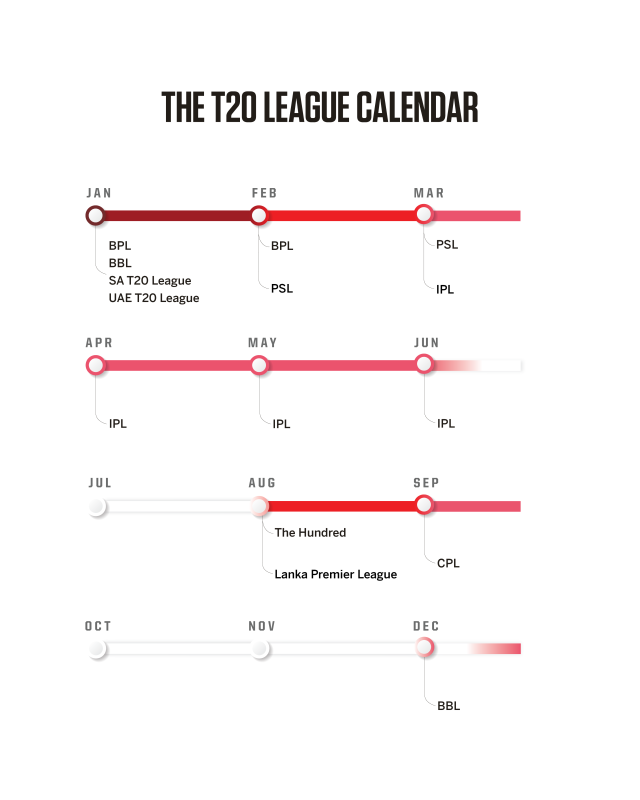I've added a few more squads...5 done out of 12+ teams.
Another thing we can track with this thread is what percentage of full strength a team is in any given match or series. But the basic rule will be all players listed in the first post will be considered the "core" players, and as long as 11 of them are in a given playing XI, the team can be considered to be at 100% full strength.
There will be some subjectivity, for example if a highly regarded young player is on debut, then technically it means someone from the squad list is missing whether its due to injury or just being dropped/rested. However if its a highly regarded debutant, then I'll still consider the team to be a full strength regarding that player.
It will be interesting to see which teams are the most injury prone, which teams rest players the most, and which teams have the most uncommitted players who prioritize franchise leagues.
Franchise vs Country: A Longitudinal Study
-
Kriterion_BD
- Posts: 7058
- Joined: Sat Nov 07, 2009 8:41 am
Re: Franchise vs Country: A Longitudinal Study
https://www.youtube.com/watch?v=JjtuZBykSzM (Noreaga - Blood Money Part 3)
-
Kriterion_BD
- Posts: 7058
- Joined: Sat Nov 07, 2009 8:41 am
Re: Franchise vs Country: A Longitudinal Study
I've decided one objective way to classify players who can be considered to be "first team" players of a side will be to take the top 10 run scorers (batsmen) and the top 6 wicket takers (bowlers) from the last 5 years for each format. Will obviously keep it to active players and ignore retired ones.
https://www.youtube.com/watch?v=JjtuZBykSzM (Noreaga - Blood Money Part 3)
Re: Franchise vs Country: A Longitudinal Study
I would say the minimum series requirement really ought to be 3 Tests, 3 ODIs and 3 T20s with my personal preference being for a 3 Test, 5 ODI and 3 T20s series.Kriterion_BD wrote: ↑Fri Dec 29, 2023 3:55 amYeah IDK know how many series are cancelled...what is clear though is that there are very few 5 match ODI series now when even 10 years ago that was the norm. I'd much rather see an ODI than a T20, but I'm in the minority of course. I think the marquee series should consist of 3 Tests, 4 ODIs, and 2 T20Is.
Re: Franchise vs Country: A Longitudinal Study
The UAE is not really a cricket backwater though, not anymore. Do you forget that's where the ICC headquarters are?Kriterion_BD wrote: ↑Sat Dec 30, 2023 6:31 amOne would think all these T20 leagues would fail. Especially in cricket backwaters like UAE or Canada. Honestly, if the BCCI can be "protectionist" and prevent their players from playing foreign leagues...other countries should do that as well, with the exception of the IPL.
Re: Franchise vs Country: A Longitudinal Study
I don't see why those leagues would necessarily struggle. As far as I'm aware they don't conflict with the IPL do they?sam_ahm wrote: ↑Fri Dec 29, 2023 3:24 pmFair points here and a good thread by Kriterion.
I have a feeling that 2024 and beyond will give us a glimpse of which Franchise leagues survive and which won't... I'm sure not every league will survive and this will be interesting to see... Some leagues that I think will struggle are - ILT20 - UAE, Global T20 - Canada, Major League Cricket - USA, Lanka Premier league - SL, CPL - WI and Abu Dhabi T10.
Leagues that will do well are IPL, BBL, SAT20 while the likes of PSL, BPL, Hundred, Super Smash - NZ may not do exceptionally well but will do good enough to survive.
Just my personal opinion though.
As far as I can tell the league schedules are basically thus:
https://www.reddit.com/r/Cricket/commen ... r_in_2023/

https://www.espncricinfo.com/story/icc- ... bl-1324926

So starting the franchise (or otherwise domestic T20) year off in December and ending it in October we have:
1. December - BBL (Aus), Super Smash (NZ), Abu Dhabi T10 (UAE) and formerly LPL (Sri Lanka) which moved to July/August
2. January - BBL (Aus), Super Smash (NZ) BPL (Bangladesh), SAT20 (S.Afr), ILT20 (UAE), Nepal T20 (Nepal)
3. February - BPL (Bangladesh), PSL (Pakistan)
4. March - PSL (Pakistan), IPL (India), Stanbic T20 (Zim)
5. April - IPL (India), Stanbic T20 (Zim)
6. May - IPL (India), T20 Blast possible month (England)
7. June - IPL (India), T20 Blast (England), T20 Inter-Prov (Ireland)
8. July - T20 Blast (England), The Hundred (England), LPL (Sri Lanka), T20 Inter-Prov (Ireland), MLC (USA), Global T20 (Canada)
9. August - T20 Blast (England), The Hundred (England), LPL (Sri Lanka) possible month, Global T20 (Canada)
10. September - T20 Blast (England) possible month, CPL (WI)
11. October - here be dragons
12. November - here be more dragons
Super Smash and to an even greater extent the Stanbic T20 are much more like the Syed Mushtaq Ali Trophy in India or the National T20 Cup in Pakistan in that they are primarily aimed at and for almost purely domestic purposes with few if any overseas players. Super Smash does allow for as many overseas players as teams want (but I think only 2 are allowed per match in the playing XI) but due to the intense competition from BBL, AD T10, BPL, SAT20 and ILT20 (the Nepal T20 being around the same time can't help since players who don't get into one of the bigger leagues can ply their trade in Nepal (cheaper cost of living) and hope to be seen or noticed for the IPL later or for one of the bigger leagues in the region (PSL, BBL, LPL, ILT20)).
ILT20, CPL, LPL and ADT10 have basically consistently been held since their inception (whereas Global T20 has had a rough time recovering from 2020 and began again in 2023) and for the most part don't compete with other leagues in terms of scheduling (LPL in July when the only competition is really England along with to a lesser extent the USA, Canada and Ireland; the CPL in September where again the only competition might just be England as well as the Asia Cup and some bilateral series (as CPL CEO Pete Russell noted from a long time ago: https://www.guardian.co.tt/sports/chief ... c143e5d9b0; he's also consistently been quite supportive of other non-competing leagues like MCL and GT20 and even recently mooted the idea that in the future the CPL, MLC and GT20 could partner to form a super league: https://www.pressreader.com/jamaica/dai ... 7432750643)).
ILT20 does compete with other leagues in January but where it differentiates itself from the other leagues is in having massively relaxed restrictions on overseas players in the playing XI. ILT20 allows 9 out the 11 to be overseas players and only stipulates that 1 player must be a UAE player and 1 player must be from an associate nation (which the UAE is, so in essence 1-2 players must be UAE players). This is almost the reverse of what happens elsewhere as usually anywhere between 2 and 5 players can be overseas players depending on the league. ILT20 differentiates itself by simply allowing overseas players maximum possibility to actually play.
Re: Franchise vs Country: A Longitudinal Study
If I'm not mistaken home boards also get a fee for the players who participate in the overseas leagues.Kriterion_BD wrote: ↑Tue Jan 02, 2024 9:40 pmThe Afghan situation has shed some light on this issue. What I didn't know was that as per current regulations, players cannot "go rogue" and say fuck the country I'm just gonna play T20 gigs. All international players need an NOC from their home board, even if they aren't centrally contracted, and even if they have retired from the game. That leaves considerable power with the home boards vis a vis the franchise leagues. Its just that so far, most countries haven't really enforced it.
The BCB has apparently told Shoriful and Taskin they cannot even sign up for the IPL auction draft...personally I highly doubt the IPL would buy them anyways. But the BCB has put its foot down, which is good to see.
One aspect thought that is now being noticed is how the current situation of many leagues and many players getting NOCs is that it is now possible that it can make more financial sense for a player if his team loses and doesn't advance to the knock-out phase/finals of one league so that he will be free to play for a team in another league: https://www.espncricinfo.com/story/a-br ... es-1420877
If the ICC and cricket boards want to avoid going back to the dark days of match fixing this is something they will need to look into soon and seriously to forestall such happenings (it may not have happened yet, but if the temptation remains it might just be too great for some players and it will be a lot harder to prove than match fixing).
Re: Franchise vs Country: A Longitudinal Study
So if even internationally retired players require NOC's, why the heck are the T20 leagues holding all the power?
Neil Johnson, Alistair Campbell, Murray Goodwin, Andy Flower (w), Grant Flower, Dave Houghton, Guy Whittall, Heath Streak (c), Andy Blignaut, Ray Price, Eddo Brandes
Re: Franchise vs Country: A Longitudinal Study
Because as best as I can remember originally only active players needed NOCs, then some of the greedier players began retiring to avoid the NOC issue and this led to a mini-crisis wherein the various boards then agreed that all players needed NOCs whether retired or not. However since the players have in the past and likely would in the future sue the various boards for "unreasonably restricting their earning potential" if the boards used the NOC without justifiable cause (like for instance wanting to rest a player ahead of a tournament or because it appears a player has decided to retire despite still being in the plans for the national team and has only retired in order to focus on T20 leagues - the latter example is one where the boards could potentially win a lawsuit since if the player has been contracted it would be very difficult for him to prove that his earnings were being unreasonably restricted since he would have been contracted and been given NOCs pretty much whenever he asked for it once a tournament or bilateral series wasn't going on), the boards are very open in issuing NOCs.
You might ask why players who aren't centrally contracted don't just retire then and I think its because unless a player becomes a really big name on the T20 circuit and is almost guaranteed to be picked by any T20 team in any T20 franchise league, they will want to continue doing both international cricket and domestic franchise cricket (if they genuinely love both) or will not want to foreclose the possibility that they can generate a higher T20 profile for later through international cricket (if they only really want to play T20 franchise league cricket). Plus if a player retires when young and decides to "unretire" later (or to retire and unretire as it suits him), there is no guarantee that the selectors won't simply avoid picking him as someone unreliable. In this regards the players don't hold the handle of the knife as they can't force selectors to pick them for international cricket via lawsuit.